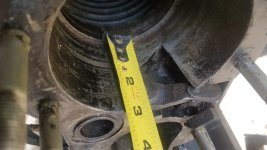jonny rotten
Petty Officer 1st Class
- Joined
- Jan 8, 2012
- Messages
- 345
Alpha one Gen one
The nut doesn't slide over the u joints
Can I slide out the shaft and bearing and whatever else is in there and just slide it back in easy with some new grease?
or....
Are there shims and possible issues involved that I definitely don't want to get involved with redoing the outdrive
I could punch out the u joints but if the shafts simply slides in and out I'd rather do that for simplicity
Reason for changing is a few of the tabs are snapped off and I'm getting water in the u joint bellows and read the fat o ring could get deformed with tabs missing and let water in.
I'm hoping is a simple outdrive gasket leak and starting here before ripping out the u joint bellows while I have the outdrive off
I guess what I'm asking is what's the easiest way to remove/install the retainer nut
The nut doesn't slide over the u joints
Can I slide out the shaft and bearing and whatever else is in there and just slide it back in easy with some new grease?
or....
Are there shims and possible issues involved that I definitely don't want to get involved with redoing the outdrive
I could punch out the u joints but if the shafts simply slides in and out I'd rather do that for simplicity
Reason for changing is a few of the tabs are snapped off and I'm getting water in the u joint bellows and read the fat o ring could get deformed with tabs missing and let water in.
I'm hoping is a simple outdrive gasket leak and starting here before ripping out the u joint bellows while I have the outdrive off
I guess what I'm asking is what's the easiest way to remove/install the retainer nut






















